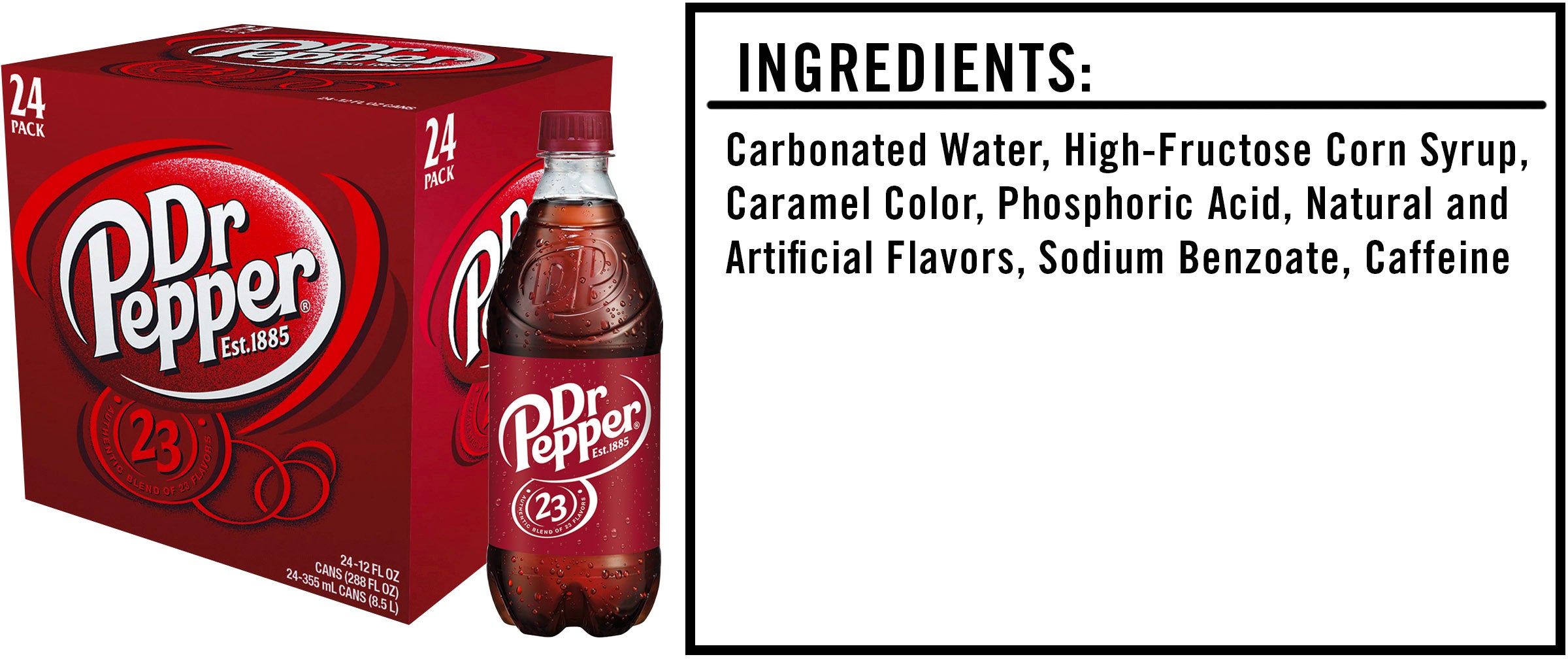We’re often told that you should never eat anything (or put anything on your body) if you don’t recognize everything on the ingredients list. But since most of us have no idea what xanthan gum or potassium benzoate are — or more importantly, what they’re doing to our bodies — we’re decoding the ingredients in the many things Americans put in (and on, or near) themselves.
This edition: Dr. Pepper, which is made from seven separate ingredients that we’ve broken down as they appear on the Dr. Pepper website.

The Dr. Pepper Ingredients
1) Carbonated Water: Bubbly!
2) High-Fructose Corn Syrup: In simple terms, high-fructose corn syrup is an artificial sugar made from the starch of corn. In complex terms, high-fructose corn syrup is the result of corn syrup that has had some of its glucose converted to fructose enzymatically.
Sadly, high-fructose corn syrup has been linked to obesity and diabetes by many, many studies. It might as well be identical to regular table sugar, and it comes with all of the same adverse effects. (For reference, a 20-ounce bottle of Dr. Pepper contains 64 grams of sugar, which is almost double what the average man should consume, and more than double what the average woman should consume, in an entire day.)
3) Caramel Color: Caramel color is what makes this soda so brown. Unfortunately, as we discovered in our exploration of the ingredients that make up Diet Coke, caramel coloring has an incredibly controversial byproduct called 4-methylimidazole (4-MEI). A 2007 study found that mice fed a diet of 4-MEI developed cancerous lung tumors as a result. The FDA quickly pushed back, noting that a human would have to consume more than 1,000 cans of soft drinks (which are notoriously high in caramel coloring) every day for two years to reach comparable levels of 4-MEI.
Who’s right is still unclear. More recent studies argue that levels of 4-MEI are, in fact, high enough in soda (and possibly other foods) and consumed in sufficient quantities by Americans to increase the risk of developing cancer. Even more recent studies say that caramel coloring is just fine. Do you really have to worry about this in your Dr. Pepper, though? Eh, all that sugar is certainly worse.
4) Phosphoric Acid: Phosphoric acid can be added to drinks to provide a sharper, more tart flavor. It also acts as a preservative to prevent the growth of mold and bacteria. Physician and biochemist Cate Shanahan, author of Deep Nutrition: Why Your Genes Need Traditional Food, previously told us that there’s no real reason to be concerned about the negative effects of phosphoric acid unless you’re prone to heartburn or acid reflux, in which case, the high acidity may induce inflammation.
- Read Next: What’s in This?: Mountain Dew
5) Natural and Artificial Flavors: Generally speaking, natural flavors are quite literally flavors derived from an actual food source — i.e., orange flavoring taken from a real orange — whereas artificial flavors are chemical compounds created in a lab that mimic a natural flavor in some way. While that may sound unhealthy, as Shanahan told us during our exploration of all 26 ingredients in nacho-flavored Doritos, these flavorings are added in such small quantities that they shouldn’t cause you any harm.
More specifically, Dr. Pepper prides itself on its “authentic blend of 23 flavors,” and legend holds that the recipe is kept as two halves in safe deposit boxes in two separate Dallas banks. While there are all sorts of guesses — cola, cherry, licorice, amaretto, almond, vanilla, caramel, the list goes on — the only thing we know for sure is that Dr. Pepper does not contain prune juice, a long-standing rumor that the company itself put to rest.
So, we may never know what’s really in Dr. Pepper as far as its flavors go.
6) Sodium Benzoate (Preservative): A preservative found in sodas, processed foods and some personal care products, like shampoo, studies suggest that high amounts of sodium benzoate could be carcinogenic. More research is needed, but it’s always wise to minimize your intake of processed foods regardless.
7) Caffeine: Reports on the negative effects of caffeine are strewn across the web, including addiction, insomnia and irritability. But as Shanahan told us during our exploration of the ingredients found in Diet Coke, “Caffeine helps burn fat.” It does this by stimulating a process called thermogenesis, which converts calories into heat energy (and explains why you might start sweating after drinking a little too much coffee). A 2005 study even found that higher-dose caffeine consumers experienced a greater decrease in fat mass, body weight and waist circumference than their less caffeinated counterparts. But then again, Dr. Pepper really isn’t the healthiest means of upping your caffeine intake.
For what it’s worth, a 20-ounce bottle of Dr. Pepper has 70 milligrams of caffeine, which is a little less than your average cup of coffee.
The Takeaway
Like most sodas, Dr. Pepper is terrible for you. It’s colored, potentially cancerous sugar water. Drink at your own risk.

